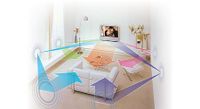Are sound bars a sound investment?
- ACME Hi Fi
- :
- ACME Hi Fi Knowledge Base
- :
- Knowledge Articles Knowledge Base
- :
- Home Theater Knowledge Base
- :
- Are sound bars a sound investment?
- Article History
- Subscribe to RSS Feed
- Mark as New
- Mark as Read
- Bookmark
- Subscribe
- Printer Friendly Page
- Report Inappropriate Content
Are sound bars a sound investment?
Question
I like the looks of a sound bar rather than speakers, but wonder how much I'm giving up on sound.
Answer
Those sleek sound bar-style speakers you're talking about look good with a flat-panel TV, and require minimal space and wiring. Most models even offer built-in amplification, which means the only other gear you'll need is a DVD or Blu-ray Disc player and a subwoofer for deep bass roar and rumble. Some of models even include a subwoofer. In a nutshell, single-speaker sound bars can deliver room-filling sound without taking up much space.
This may be the solution for you if:
- You have very limited room for speakers or other equipment. The sound bar solution requires fewer pieces of gear than any of the other options out there, and you can easily wall-mount the main speaker right below your TV.
- Very simple setup is key. You only need a couple of cables to hook up these systems, and chances are they come in the box. You won't have to run wires from one side of your room to the other, either.
- You want the cinematic thrill of surround sound but your room can't accommodate a full-fledged surround system. Some of the more deluxe models feature advanced designs and special digital processing to create a convincing, three-dimensional sound field.
However, you don't necessarily have to give up good sound for that sleek look.
While some sound bars only deliver stereo sound, others create virtual surround sound. Now, they can't give you the same precise, enveloping sound you'd get from a system with five or more speakers. But they can offer more engaging audio than your TV speakers and give you a more complete sound experience.

Before you get too much further, you need to ask yourself if you want stereo or surround sound.
Surround sound usually means at least five speakers placed strategically around the listening area, plus a subwoofer for deep, dramatic bass. But for a lot of folks, positioning speakers in the back of the room and running wire to them isn't practical. That's where sound bars that offer virtual surround sound can be especially handy. Of course, you won't get the level of precision you'd get with a conventional multi-speaker setup, but these sound bars can be surprisingly effective.
Sound bars that work as part of a full surround sound system let you combine sleek sound bar looks with the greater detail and accuracy of a conventional surround sound system. They're sometimes called "LCRs" because they provide left, center, and right channel audio from one cabinet. Note that you'll still need between two and four surround sound speakers, plus a powered subwoofer, to complete your surround sound system. You'll also need a separate home theater receiver to power the sound bar and your other speakers.
Or, you could just go with a sound bar that has a built-in amp to power it.
- Mark as Read
- Mark as New
- Bookmark
- Permalink
- Report Inappropriate Content
Before you get too much further, you need to ask yourself if you want stereo or surround sound.
Surround sound usually means at least five speakers placed strategically around the listening area, plus a subwoofer for deep, dramatic bass. But for a lot of folks, positioning speakers in the back of the room and running wire to them isn't practical. That's where sound bars that offer virtual surround sound can be especially handy. Of course, you won't get the level of precision you'd get with a conventional multi-speaker setup, but these sound bars can be surprisingly effective.
Sound bars that work as part of a full surround sound system let you combine sleek sound bar looks with the greater detail and accuracy of a conventional surround sound system. They're sometimes called "LCRs" because they provide left, center, and right channel audio from one cabinet. Note that you'll still need between two and four surround sound speakers, plus a powered subwoofer, to complete your surround sound system. You'll also need a separate home theater receiver to power the sound bar and your other speakers.
- Mark as Read
- Mark as New
- Bookmark
- Permalink
- Report Inappropriate Content
You also need to think about inputs. If you're looking at a sound bar with built-in amplification, make sure the sound bar you choose has enough audio inputs to connect your cable box, DVD player, video game console, and other audio/video gear. (This isn't an issue for passive sound bars, since you'll be connecting your audio gear to a receiver instead.) Keep in mind that you'll get higher-quality sound when you use digital audio connections like HMDI, as well as optical and coaxial digital audio — this is especially important for virtual surround sound models.

